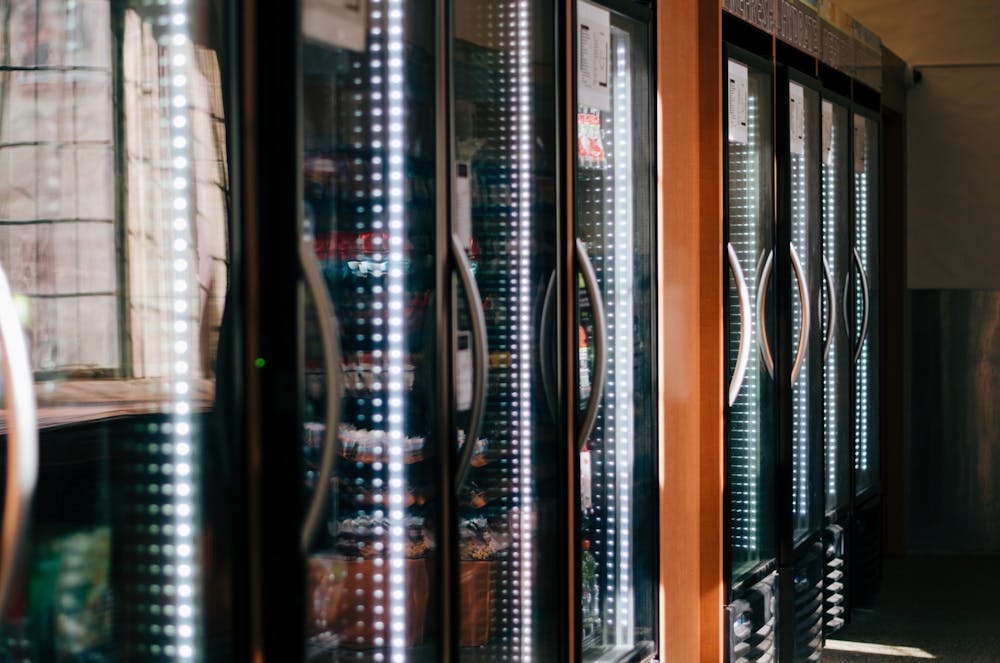“Large iced coffee, no ice for Miss Jennifer,” was a phrase I’d hear almost daily when I entered Mark’s Cafe.
Whether I was four hours deep into studying for an exam and desperately needing a caffeine fix or just grabbing a snack in between classes, Mark’s was reliable. I returned every time I worked in the library, and pretty soon the staff even knew my order. After I spent the fall semester abroad, I looked forward to going back to my place of familiarity and a staff that knew I thought ice was a rip–off. However, I walked into Mark’s this January and was met with something completely unexpected. The Mark’s I knew was replaced by two walls of food and drinks, two self checkout counters, and zero employees.
I learned that Mark’s Cafe was replaced by a new concept called the “micro–market,” a self–service eatery. Alongside Mark’s in the switch was Frontera, which became a near carbon–copy of the Van Pelt location. The new locations boast extended hours and food options for students—a few of the reasons behind the change.

But the convenience of automated dining options comes with a cost for Penn Dining staff, whose jobs were threatened at these locations, according to the union representing them. The increasing move towards self–checkout stations at Penn and the potential impact on workers raises greater questions on what—and who—is important when businesses move towards automation.
Director of Penn Business Services Pamela Lampitt says that the University was not satisfied with their previous offerings, leading to an exploration of new options that could meet more needs.
“One of the things that [Penn] wanted to do was to expand hours,” she says. “That was something that was really important to them because they have students in the library 24/7. And so to meet their needs and to provide everything that they wanted, the micro–markets sort of just fell into all of those categories.”
Lampitt also says that she had heard of students having negative experiences with dining workers, and that students with social anxiety may prefer not having to speak with someone to get their food.
After Penn Business Services decided to automate Mark’s, the same system was applied to Frontera, which is managed by Bon Appétit. However, Lampitt says the micro–market at Frontera is simply a placeholder until the University decides what should permanently occupy the space.
The automation happening at Penn’s retail locations is just one visible indicator of a trend that has been in progress for centuries. As technology develops, human workers are replaced with automated machines. Some of the first jobs to be automated were in manufacturing. The introduction of industrial robots in the 1960s and 70s allowed products to be made at a much faster rate and at much lower costs.

Automation didn’t stop with manufacturing, and it’s not likely to stop with any other sector, either. A McKinsey study found that about 50 percent of current work activities are technically automatable using current technologies. By 2030, the firm predicts that up to 30 percent of current activities will be automated.
Matthew Bidwell, a professor of management at Wharton, sees automation as mostly a positive change that lowers costs and creates convenience for the consumer. However, he acknowledges that the future is unclear.
“The last few hundred years of economic growth we've had have really been about automation,” he says. “We no longer need millions and millions and millions of people growing crops because it's all done by huge machines. We no longer need millions and millions and millions of people making clothes because a lot of it is now done by machines.”
He emphasizes the lower costs associated with an automated system, which would require only a one–time set up cost rather than regular wages paid for employees. Ultimately, he sees little problem with the type of automation occurring in Penn Dining locations, saying, “Automating kind of low skilled, poorly rewarded jobs doesn't have huge negative implications.”
“If somebody is working a minimum wage fast food job and they get automated, it's not going to be too hard for them to go find another minimum wage job, particularly in this current labor market,” he says.
But finding a job can still be difficult after layoffs, especially one with the same wages and benefits as before. In fact, laid–off workers face an average 17–30 percent permanent reduction in wages. Furthermore, if they don’t re–enter the job market within two months, resume callbacks drop dramatically.
Bidwell acknowledges that few jobs are completely immune to automation, and it’s impossible to know who will be affected next. Even in his own profession, he says many faculty are worried they will be displaced by online courses.
These fears became much more tangible for Penn Dining workers when Mark’s Cafe and Frontera closed. But according to Lampitt, the decision to automate the two dining locations was made with the guarantee that no jobs would be affected by the change.
“It's a very important consideration for us. So, you know, it would have been unlike us to put something in that we'd have to let people go,” Lampitt stated.
Teamsters Local 929, the union that represents the Penn Dining staff, has a different view on Penn Dining’s automation. John Preston, secretary treasurer of the union, says that the workers were not informed of the University’s decision to automate until a “Back to Work” meeting earlier this year. According to Preston, Lampitt spoke to the workers about the changes coming and suggested that jobs in all employment sectors may eventually be replaced by robots.
Additionally, Preston claims that the University was not as focused on keeping jobs as they say, disputing their claim that they never planned to lay off employees.
“Last year we represented up to 20 employees working at Frontera; they were laid off due to the new concept that is fully automated,” he says. “Thankfully they were represented by Teamsters Local 929, and the union was able to secure employment at the other retail food concepts on campus. The 20 or so jobs that were lost to automation are just the tip of the iceberg.”
When asked to respond to this claim, William Hess, resident district manager of Bon Appétit, said that “Bon Appétit proactively worked with union leadership to relocate all employees to other positions on campus.”
“Together, Local 929 and Bon Appétit ensured there were no workforce reductions on campus as a result of the closure,” he says. “By the time the decision was made to install a micro–market, all the former Frontera workers had already been placed in other positions.”
As problems associated with automation continue to mount, the next step is coming up with a solution. Last year’s Wharton Policy Case Competition asked participants to create a proposal focused on “ameliorating the effects of job displacement caused by advancements in technology.”

The winning project was a proposal by four Penn students, Michael Krone (C '19), Jenna Liu (C '20), Natasha Menon (C '20), and Kevin Myers (C '19). The team created a plan to shift administrative workers in the state of Pennsylvania to jobs at lower risk for automation by using state–provided development programs.
Krone, the 2019 president of the Undergraduate Assembly, says that one of the most surprising discoveries in his research was that women and people of color are disproportionately at risk for losing their jobs to automation. Krone considers the problem “ever pressing, especially when considering income and wealth gaps that already exist among those demographic groups.”
In addition to questioning the benefits of automation for workers, Krone also wonders if students will truly reap the benefits of a more automated system.
“It's a double–edged sword, especially depending on how the institution will leverage the gains from automation,” Krone says. “How are they passing those benefits along, or are they just, you know, reinvesting them into further automation? Are they lowering the prices of their goods and services, whether that's higher education tuition or soup cans, whatever they're making? How are they passing off that benefit to consumers, if at all?”
According to Penn Business Services Director of Communications and External Relations Barbara Lea–Kruger, profits are slightly above what they used to be in the old Mark’s, but she says that this could be due to the expanded hours.
Lampitt says that she considers the change a success due to the quick adoption of the new system by students.
“Students gravitate to it,” she says. “Students are using it. Students feel that it provides them access. They can use their Dining Dollars. They can get it fast.”
But Preston doubts whether the supposed positive results of the change are true.
“Ms. Lampitt blamed the student body,” he says. “‘Students want faster food. Students don't want to wait for their meal. Students are stressed for time.’ I sure would like to see the research that proves her message.”
Now when I go to Mark’s I grab my iced coffee—without ice and without human interaction—and I try to see if the supposed benefits ring true. I still wait behind people in the self checkout line, and the price of my items hasn’t seemed to change.
As new technologies develop with the ability to make production easier and cheaper, everyone in the global economy—consumers, workers, and corporations—will have a stake. Those who think their jobs are safe may be the next to become replaceable.
While no Penn Dining staff lost their jobs due to this round of automation, they, along with workers in nearly every sector, face a deeply uncertain future.
